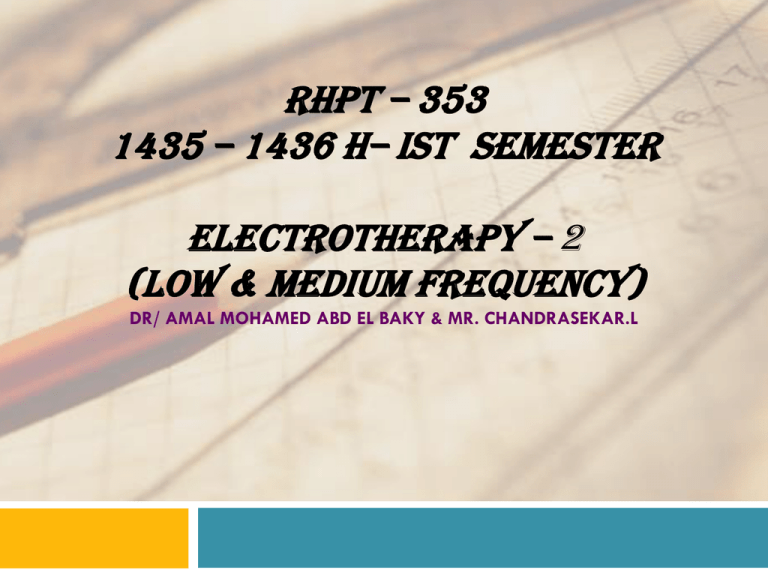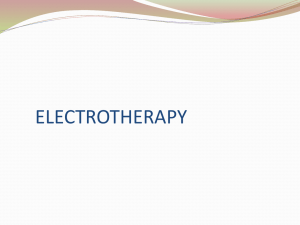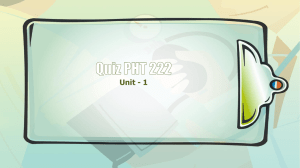UNIT-1
advertisement

RHPT – 353 1435 – 1436 H– IST SEMESTER ELECTROTHERAPY – 2 (LOW & MEDIUM FREQUENCY) DR/ AMAL MOHAMED ABD EL BAKY & MR. CHANDRASEKAR.L Lecture outline This lecture deals about the basics of electrotherapy in the following sub-categories; Terminology, Introduction, Classification of electrotherapy & basic model of electrotherapy intervention. Classification of frequencies. Key concepts in Electrotherapy / Electro physical agents Basics of Electric current / Electricity. Shock, types & Prevention strategies Learning Objective At the end of this lecture, the students will be able to; Define electrotherapy, classification of electrotherapy, Characteristics of a charged body, potential, difference of potential, capacitance, EMF, Electric current, types of therapeutic Current, Dangers of electricity & its prevention strategies. Understand the concept of basic model of electrotherapy intervention. Recall most of the stimulating agents. Compare the similarities & differences in L.F. currents. Differentiate the flow of current to different biological tissues. Introduction - Electrotherapy Electro – Electric Current / Electrical • Energy. Modality – Machines/ Equipment's. • Therapy – Treatment of disease, Non • surgical treatment approach. It means various forms of THERAPEUTIC • applications using ELECTRICAL ENERGY as primary source. Electrotherapy - Definition: Electrotherapy can be defined as the treatment of patients by electrical means. Classification of therapeutic currents according to frequency • Current in which the direction of electron flow changes periodically with a frequency of 1-1000 Hz. • Those current of 10,000 Hz or more. Low Frequency High frequency • Current in which alternate the direction of flow of electrons with a frequency between 1000-10.000 Hz . Medium Frequency Instruments used in Electrotherapy I-Low & Medium Frequency Modalities • TENS (transcutaneous Electrical Nerve Stimulation) • High-Voltage pulsed stimulation • Neuromuscular Electrical Stimulation • Galvanic Stimulation • Russian current • Faradic current • Iontophoresis • Interferential Therapy (I.F.T) III-High Frequency Modalities Shortwave Diathermy (S.W.D) Microwave Diathermy (M.W.D) Ultra Sound Therapy (U.S) Shockwave therapy IV-Actinotherapy Infra - red Radiations (I.R.R) Ultraviolet Radiations (U.V.R) Laser Therapy Other Modalities Continuous Passive Mobilizer (C.P.M) Traction unit (Cervical & Lumbar Traction) Paraffin Wax Bath (P.W.D) Hydrocollator Unit Hydrotherapy – Whirlpool therapy Fluido - Therapy LOW & MEDIUM FREQUENCY MODALITIES IFT IONTOPHORESIS TENS FES HVPS Introduction – Changing nature of Electrotherapy Electrotherapy is a long-established place in therapy practice. From the published & experimental evidence, it appears that electrotherapy can be clinically effective. The evidence would suggest that when the appropriate modality is applied at the right dose for the presenting problem, it can make a significant contribution to the improvement & well being of the patient. For any therapeutic intervention to be effective there is a need for a clear assessment, a rationalization of the problems(s) & the construction of a proposed treatment plan that matches the needs of the individual taking into account their holistic circumstances, not just their presenting signs & symptoms. The thinking therapist then re-evaluates the outcomes as the treatment progresses, modifying the treatment package in the light of these results. (+, -) Treatment package tailoring is an essential skill for any therapist. The research evidence suggests that electrotherapy can be effective as an element of treatment. Further work is needed to evaluate the combinations or treatment packages – that are most effective. The classification of Electrotherapy (Electrophysical Agents – EPAs) Electrical Stimulation Agents / Modalities Thermal Agents / Modalities Non Thermal Agents / Modalities Infra Red Irradiation (IRR) [Pulsed] Ultrasound Interferential Therapy (IFT) Shortwave Diathermy (SWD) Low Intensity Pulsed Ultrasound (LIPUS) Neuromuscular Electrical Stimulation (NMES) Microwave Diathermy (MWD) [Pulsed] Shortwave Therapy (PSWT) Functional Electrical Stimulation (FES) Other RF Therapies [Pulsed] Laser Therapy (LLLT / LILT) Faradic Stimulation Hydrocollator Packs [Pulsed] Microwave Therapy Iontophoresis High Voltage Pulsed Galvanic Stimulation (HVPGS) Wax Therapy Balneotherapy ( inc spa/whirlpool) Low Intensity RF Applications Pulsed Electromagnetic Fields (PEMF’s) Fluidotherapy Microcurrent Therapies Therapeutic Ultrasound Magnetic Therapies Laser Therapy Pulsed Magnetic Therapy Transcutaneous Electrical Nerve Stimulation (TENS) Low Intensity Direct Current (LIDC) and Pulsed LIDC Twin Peak Monophasic Stimulation Diadynamic Therapy H Wave Therapy ; Action Potential System (APS) Russian Stimulation : Medium Frequency Stimulation Rebox Therapy; Scenar Therapy Microcurrent Therapy (MCT) Static Magnetic Therapy Cryotherapy / Cold Therapy / Ice / Immersion Therapy Microcurrent Therapy Basic Model of Electrotherapy Intervention A simple, but effective clinical decision making model (represented in the adjacent diagram) can be utilized. All electrotherapy modalities (with the exception of biofeedback) involve the introduction of some physical energy into a biologic system. This energy brings about one or more physiological changes, which are used for therapeutic benefit. Basic Model of Electrotherapy Intervention Classification of frequencies Low frequency current ranging from 0 to 1000 Hz Medium frequency current ranging from 1000 to 10000 Hz High frequency current ranging from 10000 Hz onwards ELECTRICITY – Basic concepts explained Matter- any material that occupies space and has mass. Elements - all matter are made of elements, over 100 elements are known. Compounds - combination of two or more elements joined together at the atomic level. Atom - the smallest recognized particle of matter that retains the properties of a given element. Atoms of elements are combined together to form compounds. The atom consists of : A) Protons - very dense, positively charged B) Neutrons - dense, neutrally charged C) Electrons - negatively charged particles that orbit very rapidly about the nucleus of an atom. Atomic charge balance - all atoms contain the same number of negative electrons as positive protons, thus as neutrons have no charge, then net positive charges = net negative charges (protons = electrons) Valence electrons - the electrons present in the outer energy level that are available for atomic bonding. Ionic Bonds - bonding in which one or more valence electrons are transferred from one atom to another. Ions - electrically charged atoms. positive ions - tend to lose electrons during bonding negative ions - tend to gain electrons during bonding. Two particles of opposite charge attract each other & two particles of the same charge repel each other. Potential It is electrical condition of that body when compared to the neutral potential of the earth Bodies with an excess of electron are called negative Bodies deficient in electrons are called positive The Unit of potential is volt Capacitance It is the ability of the body to hold an electrical charge Capacitance depends upon the material and surface area of the body. There is inverse relationship between capacitance and potential (larger the body the smaller the potential) Difference of potential Exists between similar bodies charged with different quantities of electricity. Electron moves from the more negative to less negative one. The force producing the movement is called an electro motive force (EMF) The charged body is continually seeking to attain its neutral state: if negative, by losing electrons; if positive gaining electrons. Characteristics of charged body These shows certain properties 1.The lines of force (LOF) surrounding an isolated charged body are straight. 2.Lines of force (LOF) repel one another. 3.LOF pass more easily through conductors than through insulators 4.LOF concentrate on that part of the surface of a charged body nearest to another object over which they can exert an influence. Electric Fields - LOF An electric field exists around any charged particle. If a smaller charge that is free to move is placed in the field, the paths it will move along are called lines of force. Examples of electric fields near charge particles and plates Electromotive force - EMF Electromotive force, or most commonly emf (seldom capitalized), or (occasionally) electromotance is "that which tends to cause current (actual electrons and ions) to flow. More formally, emf is the external work expended per unit of charge to produce an electric potential difference across two open-circuited terminals. The electric potential difference is created by separating positive and negative charges, thereby generating an electric field. The created electrical potential difference drives current flow if a circuit is attached to the source of emf. Electrical energy Electrical energy is the energy carried by moving electrons in an electric conductor. It cannot be seen, but it is one of our most useful forms of energy because it is relatively easy to transmit and use. Electric Current / Electricity An electric current is the flow of electric charge (Usually electrons) in a circuit. Factors essential for production of electrical current are 1. Potential difference (PD) 2. Conducting pathway (between two points of PD) Higher potential It is measured in – Amperes (A) PD (+ -) Lower potential Presence of Potential difference Generation of electric current / electricity Types of electricity / Current Currents can be classified into 1 . Alternating (AC) 2 . Direct (DC) 3 . Pulsatile (PC) TYPES EXPLAINED 1. Direct current (DC) The current flows only in one direction. 2. Alternating (AC) The continuous flow of electrons is bidirectional Electrons flowing in an alternating current always move from the negative to positive pole 3.Pulsatile (PC) Contains three or more pulses grouped together and may be undirectional or bidirectional CURRENT FLOW THROUGH BIOLOGIC TISSUES Electrical current tends to choose the path that offers the least (LESS) resistance to flow. The conductivity of the different types of tissue in the body is variable. Typically, tissue that is highest in water content (highest in ion content) is the best conductor of electricity. The skin has different layers that vary in water content, but generally the skin offers the primary resistance to current flow and is considered an insulator. CURRENT FLOW THROUGH BIOLOGIC TISSUES Blood is a biologic tissue that is composed largely of water and ions and is consequently the BEST electrical conductor of all tissues. Muscle is composed of about 75 percent water. Muscle tends to propagate an electrical impulse much more effectively. So it is a good conductor. Peripheral nerve conductivity is approximately six times that of muscle. Fat contains only about 14 percent water and is thought to be a poor conductor. Bone is extremely dense, contains only about 5 percent water, and is considered to be the poorest biologic conductor of electrical current. Therapeutic uses of electricity – Focusing on Low frequency currents Main uses of electricity are: 1. Muscle contraction Re education of the muscle To improve muscle strength To prevent atrophy of muscles To increase range of motion To increase muscle pump contraction Cont…. 2.Sensory stimulation To reduce pain Used as placebo effect 3.Ion movement 4.Analgesia 5.Recent researches shows Fracture healing Wound healing Ligament and tendon healing Terminology – APTA monograph (2001) Sl.no Recommended term / Electrical Terminology Outdated, Vague & Erroneous Terminology 1. Direct current Galvanic current 2. Faradic current 3. Pulsed biphasic asymmetric balanced current High-voltage pulsed current 4. Balanced Waveform Zero net DC 5. Pulse duration Pulse width; pulse length 6. Current amplitude Current intensity 7. Frequency Rate 8. Waveform Impulse 9. On:Off ratio Mark:space ratio 10. Ramp Surge High-voltage pulsed galvanic current Dangers of electricity • Definition shock • A shock is a painful stimulation of sensory nerves caused by sudden flow, cessation or variation in the current passing through the body. Severity of shock • The greater the current which passes through the body, more severe is the shock. Most apparatus used in physiotherapy departments is plugged into the mains supply of 240/110 volts and frequency of 50/60 Hz. This therefore represents a Danger of electric Shock. Dangers of electricity – Cont…. Severity of shock Severity of shock • If exposed parts of the circuit are touched with damp ( wet) hands the shock is more likely to be severe than if the hands are dry. • The severity of the shock also depends on the path taken by the current. • The strong current through the head, neck, heart or whole body prove fatal. Severity of shock • Shocks are also generally more severe with alternating current than with direct current • because the intensity of alternating current (AC) is continually changing and so it provides stronger sensory stimulation. • it may also produce tetanic muscle contractions, which make it impossible for the victim to let go off the conductor. A sudden increase in the current. If the patient touches the exposed part of the circuit On making contact with metal casing of apparatus can also occur if the intensity control is turned up Suddenly) Types & effects of Shock Minor shock • frightened • Distressed • usually does not lose consciousness . Severe shock • Fall in blood pressure (BP) • Sometimes loss of consciousness . Extreme shock • Cessation of respiration (This is recognized by absence of respiratory movements and cyanosis.) • Cardiac arrest • this is recognized by absence or abnormality of respiratory movements , absence of pulse in the carotid artery and fully dilated pupils. Treatment of electric shock The first step is to disconnect the victim from the source of supply; the current should be switched off at once. If there is no switch in the circuit the victim must be detached from the contact of conductor. Following a minor shock the patient is reassured and allowed to rest. Water may be given to drink. Must avoid hot drinks because that in turn can cause vasodilatation and sweat Burn It caused by: Contact of the metal to the skin Over dosage Skin lesion Metal in the part. Concentration of current It is caused by: The presence of un-dissolved salt in solution Creases on the pad Pads unevenly moist Any raised skin edges Precautions Check the equipment thoroughly. Wires should be checked for insulation Proper instructions should be given to the patient





